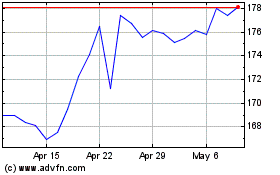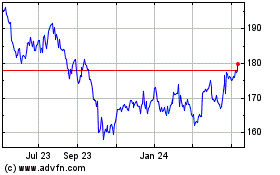By Saabira Chaudhuri | Photographs by Zach Gibson for The Wall Street Journal
Glassmakers are betting the backlash against single-use plastics
can stem a decadeslong decline in the use of their bottles and
jars. First they have to boost poor glass-recycling rates that
undercut the material's environmental pitch.
Once the packaging kingpin for milk, ketchup, beer and soft
drinks, glass has been muscled aside by lighter, unbreakable
materials such as plastic and aluminum. Today, just 1% of U.S. soda
comes in glass bottles, down from nearly 58% in 1975, according to
Beverage Marketing Corp., a consulting firm. Over the same period,
plastic jumped to 32.5% from nothing.
Now, mounting concern about the environmental impacts of
single-use plastic is dampening its appeal for some consumers. That
is prompting consumer-goods companies like Nestlé SA, PepsiCo Inc.
and Unilever PLC to explore refillable packaging and alternative
materials.
Glassmakers see this as an opportunity to win back customers. A
recent industry-funded marketing campaign in Europe saw
grocery-store customers thanked by on-screen dolphins for helping
the oceans when they scanned items packaged in glass.
"It's hard for us to ignore the images borne into our minds of
trillions of plastic packages floating around the Pacific Ocean,"
Andres Alberto Lopez, chief executive of O-I Glass Inc., told
investors last year. "Glass represents a wonderful
alternative."
The U.S.'s first new glass container plant in 12 years, a $123
million facility, is being built by Arglass Yamamura LLC in
Georgia. Perrysburg, Ohio-based O-I, the world's biggest maker of
glass containers, is investing more than $60 million to build a new
furnace at its French plant, its first such expansion in the region
in two decades. Glassmakers also are investing in new technology to
quickly swap colors and molds in a bid to woo craft brewers and
small brands, in a break from the long production runs that have
dominated the industry to date.
Glassmakers say their products -- made from sand -- are
all-natural, endlessly recyclable and can be refilled many times.
Glass is the only widely used food packaging material that the Food
and Drug Administration deems "generally recognized as safe,"
meaning it doesn't need premarket approval. It also offers a longer
shelf life for many food and drink products because it is less
permeable than plastic, said Sokhna Gueye, Nestlé's plastics
sustainability manager.
But there are cracks in the glass industry's sustainability
story, particularly in the U.S. Glass containers often break and
are heavy to transport, leading to increased fuel use. Efforts to
bring back refillable glass containers for beer, soda and milk have
remained niche. And most important, about two thirds of glass
containers aren't recycled in the U.S., according to the
Environmental Protection Agency.
Recycling them often isn't cost-effective, processors say. That
is because most American households throw glass containers in the
same recycling bin with paper and plastic, where it breaks and is
hard to separate. Broken glass also rips up conveyor belts at
sorting facilities and costs more to transport to increasingly
faraway glass plants. The number of glass-container plants in the
U.S. has fallen 65% since 1983 as demand for soda bottles has
dropped.
"For a long time there was the thought glass was being recycled,
but in reality it was not," said Erik Grabowsky, head of solid
waste for Arlington, Va., one of a rising number of places that no
longer offers curbside collection of glass. The county's glass
containers had long ended up in landfills because they weren't
clean enough for recyclers to buy, Mr. Grabowsky said.
In response, glassmakers are attempting to boost recycling rates
by funding separate glass-collection programs in areas that lack
the infrastructure. O-I and Mt. Pleasant, Pa.-based recycler CAP
Glass sponsored pop-up recycling events for Pittsburgh residents to
drop off glass containers after the city's residential waste
contractor said it would no longer accept them. The industry
recently set up a foundation to improve recycling
infrastructure.
Arlington and other counties in Northern Virginia last year
began rolling out separate purple bins for glass. Local officials
say the program has proved popular, with some of the glass
collected being used by Strategic Materials Inc. -- the U.S.'s
biggest glass-container recycler -- to make new bottles. But
getting big volumes remains a challenge, recyclers say.
Despite industry efforts, the share of new U.S. drink launches
packaged in glass last year fell to 25% from 37% in 2015, according
to research firm Mintel. "There is an opportunity to capitalize on
the backlash against single-use plastics, but it is very hard,"
said Nipesh Shah, CEO of Tampa-based Anchor Glass Container Corp.
"The first part is preventing the conversion from glass to
plastics."
One hope for glassmakers is that consumer interest will revive
refillable glass containers. The carbon footprint of single-use
glass is a turnoff for companies like PepsiCo, said its head of
sustainability, Simon Lowden. A 0.75 liter glass bottle must be
used three times to bring its carbon footprint in line with that of
a half-liter plastic bottle, according to a study in the
International Journal of Life Cycle Assessment.
Coca-Cola Co., Procter & Gamble Co., Nestlé, PepsiCo and
Unilever are among companies participating in a trial called Loop
through which they sell products like Tropicana orange juice and
Hellmann's mayonnaise in containers designed to be returned,
cleaned and refilled. Of the 300 products included in that trial,
more than half are packaged in glass.
"When a glass bottle is refilled it's very attractive from a
carbon footprint standpoint," said Ben Jordan, senior director of
environmental policy for Coca-Cola. "When it's not, it's at the
other end of the spectrum."
Write to Saabira Chaudhuri at saabira.chaudhuri@wsj.com
(END) Dow Jones Newswires
February 24, 2020 05:44 ET (10:44 GMT)
Copyright (c) 2020 Dow Jones & Company, Inc.
PepsiCo (NASDAQ:PEP)
Historical Stock Chart
From Mar 2024 to Apr 2024

PepsiCo (NASDAQ:PEP)
Historical Stock Chart
From Apr 2023 to Apr 2024
